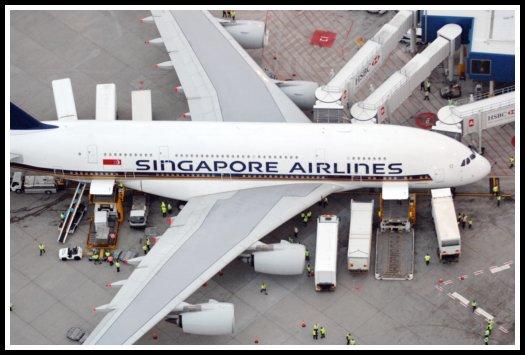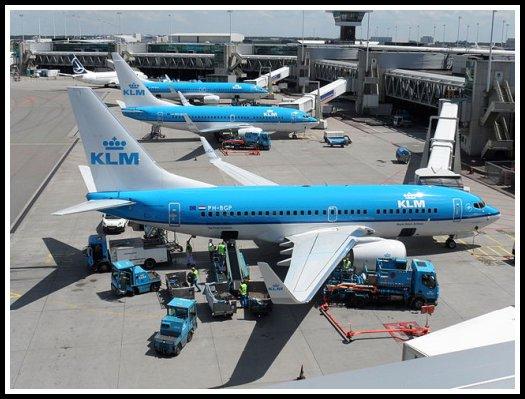Aircraft ground handling apron systems
That is the trouble with flying: We always have to return to airports. Thank of how much fun flying would be if we didn't have to return to airports.
- Henry Minizburg.

Ground handling of a Singapore Airlines Airbus A380
The apron at a large modern airport is not only the concrete or
tarmac surface itself. In order to reduce surface traffic across the apron, to
improve the apron utilization and to reduce the ground time, the systems needed
for servicing an aircraft are either buried in the surface or located under
passenger bridges. The fixed ground systems considerably improve the apron
safety by reducing the number of service vehicles on the apron and especially
in the vicinity of the aircraft. But even when fixed ground systems are used,
around 21 different pieces of ground support equipment might be employed for a
standard Airbus 380 turnaround, a similar number as for existing large
aircraft. Apron accidents and incidents are sometimes not defined as
aviation accidents and are investigated according to different standards. This
practice contributes neither to the apron safety enhancement nor to the
creation of a positive safety culture. The work environment on the apron is
often not the best one for safe and speedy ground operations. The workers are
exposed to congestion, stress, noise, jet-blast, extremes of weather and
sometimes to low visibility conditions. The open apron space and differences in
aircraft size may lead to a vehicle driver’s misperceptions of the distance or
the speed. Sometimes the workers are penalized for turnaround delays or
schedule disruptions. Handling companies frequently employ low-paid and poorly
motivated workers with a high rate of staff turnover. All these factors create
potential hazards for apron accidents and incidents. Apron accidents sometimes
involve minor damage only, but when unnoticed or unreported, they may result in
an aircraft emergency. Minor damage can also be expensive for airline
companies. Even if the aircraft repair may not be costly, the indirect costs
resulting from the schedule changes and consequent disruptions are much higher.
Apron incidents involving aircraft are most serious. These are often caused by
passenger handling or aircraft servicing equipment. Damage either to aircraft
by moving equipment or to moving equipment by other equipment can be
considerably reduced by installing fixed services. An apron equipped with fixed
ground systems has a lower impact on the environment due to lower noise and
exhaust emissions. Equally important is reduced traffic in the maneuvering
area. It also leads to saving on personnel which is significant especially in
countries where the cost of labour is high. However, the latest initiative, the
so called "free ramp concept" is also found at China – Beijing
airport. The equipment and networks buried in the apron require higher initial
investment costs but, in general, reduce operational costs. It is, therefore,
more suitable especially for airports with high daily utilization of stands.
Before the decision concerning a particular type of ground handling is taken,
it is necessary to carry out a detailed analysis.

With fixed distribution networks buried either in the apron or fixed on passenger bridges, it is possible to provide:
- aircraft refueling
- electrical power to aircraft systems
- telephone and data connection
- air conditioning
- compressed air for the engine start
- potable water
- lavatory service
- push-back of an aircraft
- transport of baggage to/from aircraft
- waste removal
The ducts for air conditioning are light and of large diameter, so can be caught by the wind and blown out. This makes it difficult to control when trying to make a connection with the aircraft. In fixed systems, fuel is always supplied to hydrants through pipes buried in the apron, while the systems on the passenger bridges provide air-conditioning, power and compressed air supplies. It is important that servicing lines between the aircraft and the installation should be as short as possible and they should not cross one another. In the future, especially at airports which accommodate wide-bodied aircraft, a further expansion of ground support systems is to be expected. All manufacturers supply Airport Planning Manuals that indicate the notional time needed for turnarounds without any operational difficulties, and also the location of all the servicing points and the way in which simultaneous activities can be carried out without mutual interference.
UTC | Zulu Time
Copyright © 2012 Roger. All rights reserved. | Sitemap